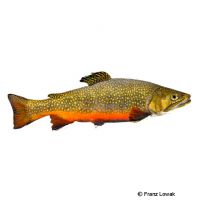Brook Trout (Salvelinus fontinalis)
| Brook Trout Salvelinus fontinalis | |
|---|---|
| Name | Brook Trout |
| Name Lat. | Salvelinus fontinalis |
| Family | Salmonids |
| Family lat. | Salmonidae |
| Order | Salmons |
| Order lat. | Salmoniformes |
| Origin | Global |
| Habitat | Rivers, streams, lakes |
| Diet | Carnivore |
| pH | 6.0-8.0 |
| Behavior | Predatory |
| Keeping | Individual, group |
| Care Level | Moderate |
| Reproduction | Substrate spawner |
| Breeding | Moderately difficult |
| Life Span | 5-8 years |
| Protection | No |
| Metric Units | |
| Size | 30-40 cm |
| Temperature | 4-18 °C |
| Hardness | 10-20 °dH |
| Aquarium | Ponds |
| US Units | |
| Size | 12"-16" |
| Temperature | 39-64 °F |
| Hardness | 178-356 ppm |
| Aquarium | Ponds |
Distribution and habitat
The brook trout originated in eastern North America, was introduced to Europe in 1884, bred as a popular food fish, and is now common worldwide, in all waters suitable for them. They prefer to live in cool oxygen-rich rivers, streams and lakes. There are populations that differ in their markings and coloration
Maintenance
A very large pond with cool, oxygen-rich water, with a medium current, a substrate of round-grained gravel and plenty of free swimming space is recommended. Pond plants and oxygen-giving underwater plants (water milfoil, waterweed, hornwort, etc.) should not be missing
No ammonia, ammonium and nitrite should be detectable in the water, and the nitrate value should not exceed 100 mg/l. To ensure the water quality and oxygen content, a filter adapted to the water volume is necessary.
Diet
In nature, predatory fish feed on insects (approach food) and insect larvae, worms, small amphibians, snails, fish spawn (spawn predators) and small fish. In pond keeping, the food supply consists mainly of a high-quality, high-protein dry feed for trout (granules, pellets). The ideal feeding time is from morning to early afternoon. Feed only as much as is eaten in a few minutes, but not more than 1% of the body weight per day
Behaviour and compatibility
Juveniles live in schools, whereas adults tend to be territorial loners.
Only in sufficiently large ponds several animals can be kept together. A socialization is only recommended with larger fish
In principle, only mutually compatible fish species with similar requirements for water quality and water temperature may be kept together.
Reproduction and breeding
There are no known external distinguishing characteristics between males and females. At spawning time both sexes are magnificently colored.
The spawning season lasts from October to March at a water temperature of 5-8 °C. The female creates a pit in the gravelly-sandy bottom by rapid movements of the caudal fin, in which she lays her eggs. After fertilization, the spawning pit is covered again with sand or gravel.
Depending on the water temperature, the larvae hatch after about 3 months and swim free after 3 to 4 weeks.
Important
For native brook trout, brook trout represent food and habitat competitors.
The brook trout is an economically important commercial fish for mass production in aqua farms and for pond farming
If they are overwintered in the pond, adequate depth and oxygen supply (filter, oxygen dispenser, ice free holder) must be provided. At temperatures below approx. 5 °C and above 16 °C, hardly any food is accepted, and feeding must be adjusted accordingly
The well-being of the fish must be checked regularly. A regular partial water change, according to the pond size, is recommended, even if the pollution level has not yet reached the upper limit. Sudden changes in water quality should be avoided. Newly introduced fish must be accustomed to the water slowly
Further literature can be found in your pet store.
References
Text: petdata; Image: Franz Lowak
Source: BMELV (1998): Tierschutzgutachten - Haltung von Zierfischen (Süßwasser); RIEHL & BAENSCH (2006): Aquarien Atlas Bd. 3, Mergus Verlag; ENGELMANN (2005): Zootierhaltung - Tiere in menschlicher Obhut: Fische, Verlag Harri Deutsch
- Gemäß § 21 Abs. 5 Tierschutzgesetz idgF
